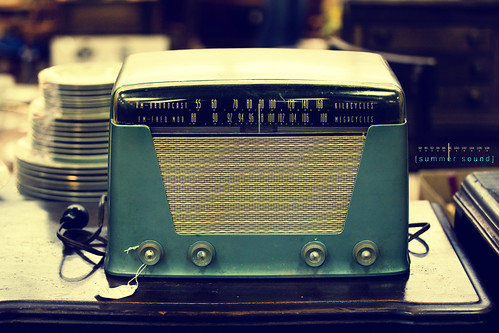Each project group (comprised of 4-5 people) will write, produce and record a radio show around a theme. These should show the forms and characteristics of the radio shows you listened to in week 4, and demonstrate the ideas of shapes of stories we looked at in Week 3.
Groups will be self-selected via our shared google doc. Each participant is asked to design a proposed logo for their group in week 6; the team should produce a poster for their show as well.
Each radio show should be no more than 5 min X the number of group members. In other words, a four person group should produce at a 20 minute or less show. A five person group should produce a 25 minute show. Got it? Make it tight.
In addition, each participant should produce in week 7 a bumper (15-30 seconds) for their particular show and a commercial/promo (~60 seconds).
Your group should decide on a theme by the end of week 6; these are just suggestions.
- Seasons: Fall and Spring are seasons that represent change, renewal, a new start. Build a whole story that is based on this season, overcoming challenges, etc.
- Roadtrips: Everyone loves a roadtrip — the lure of the open road, the wind rushing through the windows, the smell a new place. Build a show around the adventure and mystery of the road trip.
- Mystery/Suspense Create a sense of intrigue, or challenge, or a narrow escape from a bad situation. Zombie attacks, alien invasions, post=apocalyptic survival all are on the table
- Time Travel: What would happen to go back or forward in time?
- Parody: Recast a known show or character into a new frame. Stay in taste!
- Something Else: Don’t like these choices? Okay. Propose something else!
It may help to review the kinds of shows done in the past; see the archive of past radio shows. You may choose your format from the following types:
- Radio Drama: Write a fictional story around your theme and produce a radio drama, complete with sound effects, musical overtures, and funny voices.
- Interview Show: Either conduct a panel interview (with group members) or interview people from around campus/your neighborhood/your workplace about the theme. Warning: It is HARD to do entertaining and interesting interview shows. We’re not looking for boring people droning on about things. You’ll have to be creative to make an interview show interesting. They need some structure, and do not work as off the cuff banter. Use techniques demonstrated by shows like This American Life and/or Radiolab.
- Soundscape: Choose a variety of audio assignments from the audio section in the Assignment Repository, and produce them around your theme. Come up with an eclectic and interesting mix of audio pieces; make sure to build interludes between them. Work on producing a show that unifies these disparate pieces.
- Something Else: Don’t like these choices? Okay. Make it good.
Whatever you do should have a structure similar to the ones we listened to- some sort of introduction, a mid show reminder, use of bumpers and commercials in the middle of a show, and an outro (or exit).
Timelines
Week 4 & 5 Form groups via the shared document, set up how you will communicate, collaborate, roles, and how you will share media.
Week 6 (by midnight): Start work to settle on a theme and format for your show. One designated group member should write a blog post outlining these choices. Each participant tudent should design a proposed logo and/or poster for their show.
Week 7 & 8 Hard core production mode- recording audio, gathering effects, music, editing.
Week 9: Radio shows and bumpers should be completed and uploaded to Dropbox at http://dropitto.me/ds106 (the password is “wejamecono”) so we can add them to the rotation of ds106radio and add them to our radio show archive.
Week 9 : The shows will be put into the ds106 scheduled programming. If you wish to do a live premiere and talk about your project, make sure someone from your group has a handle on broadcasting to the radio
Note: As soon as groups are formed, you should begin working together to make decisions about your show. As soon as you know what you’ll be doing for your show, you should begin working on it! While we will be moving into other units for the next two weeks, we encourage you STRONGLY to not wait until the last minute to work on this project!
Group Communication
It is your responsibility, as a group, to determine the best way to manage group communications. You may use whatever tools you like. Here are a few suggestions:
- Email: Once your groups have been formed, we will send out an email to each group so that you all have access to each other’s email addresses. You may use this to facilitate conversation.
- Twitter: You may wish to choose a hashtag for your group and ask everyone to use it whenever writing a tweet related to their work on the show.
- Google Hangout: If you’re looking for a tool for group meetings/conversations, Hangout is a good choice. You can each have audio/video as well as sharing screens. You can also record these sessions.
- Skype: Skype is always a good (free) choice for conducting group discussions. You can have an unlimited number of audio connections in a Skype call. In order to do group video calls, however, you have to have a Premium subscription (there is a free 7-day trial).
- Your Blogs: While some blogging will be required as part of this project, we encourage you to go beyond those requirements. Use your blog as a place to narrate your show’s progress, communicate questions to your group, and ask for help!

cc licensed ( BY NC ) flickr photo shared by Brandon Christopher Warren
You will receive a group grade on your radio show, as well as an individual grade for your work in the show (based on your reflections on your blog). Generally, shows should demonstrate the following:
- Creativity: Your show should creatively interpret your theme in a way that makes for an enjoyable (not boring) listening experience. It is NOT considered creative to pick a theme and then have every person simply turn on a mic on their computer and talk about it. Plan your show/segments. Think about what kind of audio techniques and storytelling techniques you can use to make it/them as entertaining as possible!
- Quality: We know that you’re not audio experts and that producing really good radio takes years of practice. However, we still expect a modicum of basic quality from your show. We should be able to understand what you are saying. There shouldn’t be a lot of background noise or static. Music and effects should be clear and well-modulated. The sound shouldn’t go in and out or have dramatic changes in volume.
- Groupwork: In order to produce a really solid show, you will need to work well together. The best shows involve regular communication and collaboration among members, particularly during the planning stages. The weakest shows tend to be ones where the groups pick a theme and then everyone goes off in different directions and they don’t really consult on how everything goes together.



Add a comment